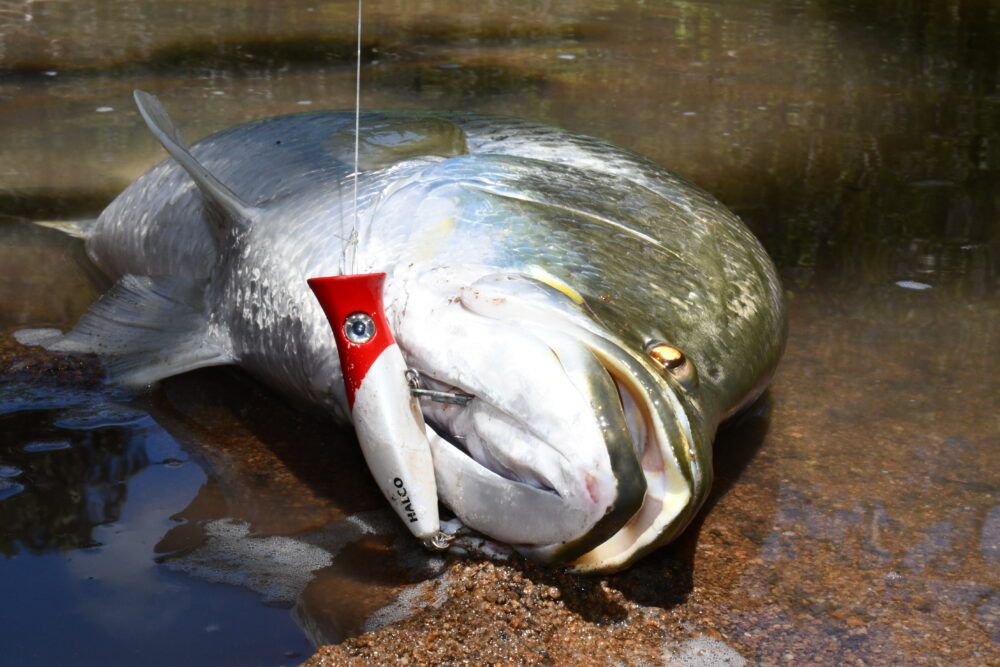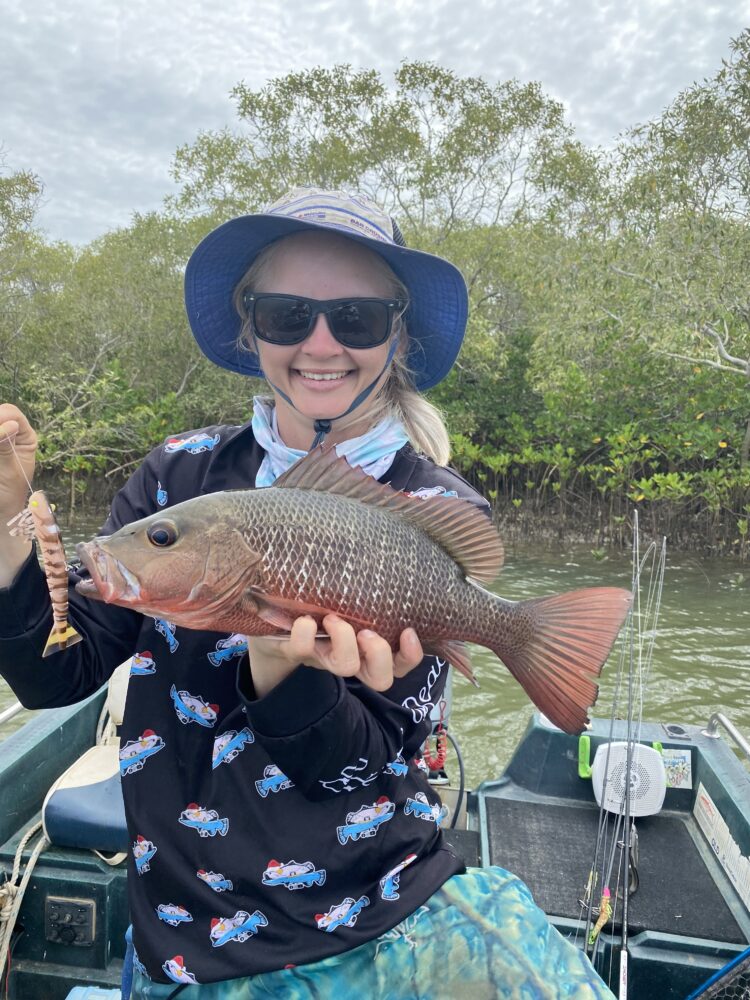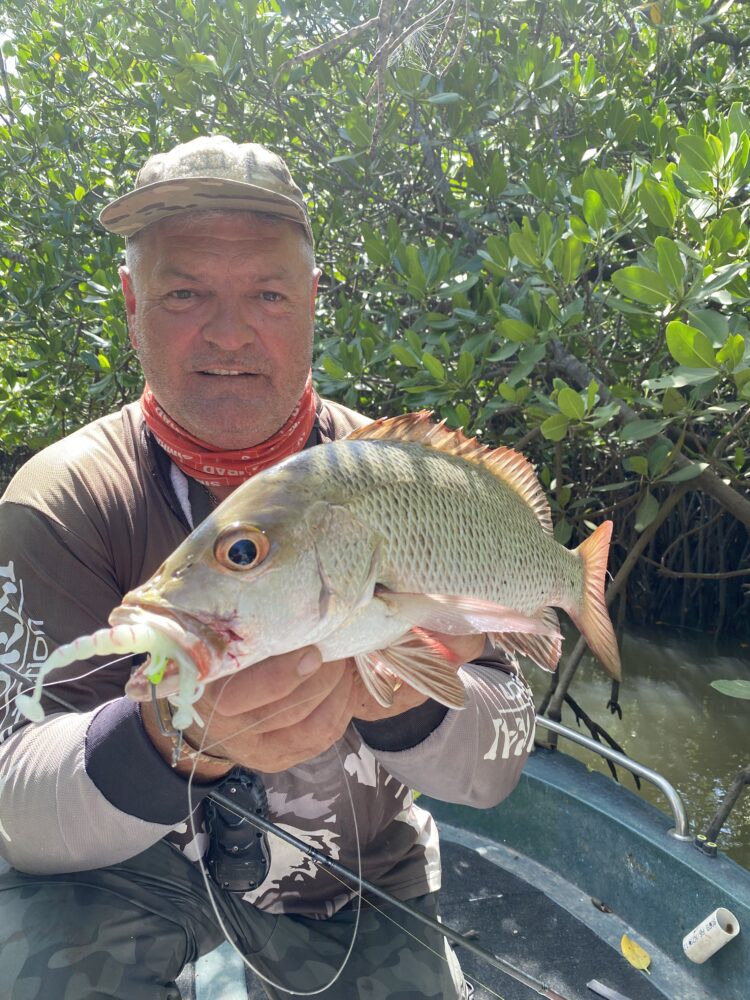Lure Colour and Contrast – Part 2 – By David Hodge
It’s really hard to let such a topic like the last months one I wrote go when you feel there were so many things you could have added, but ran out of space. After talking with our editor about the expansion of relatable items associated with the topic, he thought it a good idea to do a part 2, and I agree. So here are some of our own personal theories and techniques that ‘maybe’ help us to catch our share of fish.

Again high in UV content, the Atomic Prong in Radioactive Rooster colour scheme is a killer in dirty water. Every one of our hook weights are coated with the hard to get Protec Powdercoat.
Night time is one such topic that could be set out on its own to be honest, but given the fact that not everyone casts lures, we should delve a little deeper into the low light, deeper water scenarios such as trolling. Many years ago I made and sold a timber lure called a Hodgie’s Hypo’s. The name related to the hyperactive action they had through body design and bib combination. Mind you, they weren’t made for the barra, jacks or fingermark, but more the Murray cod yellow belly (golden perch) and bass, with wider, slower and more ‘thumping’ actions. Western Red and White Cedar was the timber type I had easy access to, and the paint jobs in comparison to the master pieces that are so incredible these days, we’re very rudimentary. I remember experimenting and researching (fishing), extensively to try to combine some of the most effective colours I could to make them as successful as possible. The most effective lure colours for fishing weren’t always the most popular to sell though, and this is where that old expression,
‘pretty lures catch more fisherman, than fish’
, and I’d have to agree. For instance, possibly the most effective lure colour I ever used for the cod at night, was a stark white base, red or black aggressive stripes on the sides with a light or lime green back. All paint jobs had the traditional red throat to signify the flared gills. I’m going to do some of our old faithful lures that have been placed in the retired box in these colours and compare the different results for northern stuff, but I’m expecting it to be quite similar.
The lead up to full moon and just after the full, down south had very similar patterns for Murray cod to the northern equivalent in prestige, the barra. I experimented with plenty of contrasting colours and silhouette patterns as well, and it wasn’t as cut and dried as you’d think. Spending a lot of time in the shallow fringes of dams and winding western flowing rivers and gorges of the New England area, it was my aim to find a consistent night time colour that would be “one to rule them all”. Over quite a few trips it became apparent that on the same moon phases, it was the depth that dictated a lures effectiveness, and it’s very similar for the barra, in my opinion.

Do fish really think that the red is flared gills or is it more the stark contrast between the two colours that get their attention.
Long story short, this is what ended up being as close to a consistent pattern as I could find. The shallower the water, the darker the base colour needed to be. By that I mean the majority of the lures colour scheme, but the contrast was important. With the swim baits, surface lures and shallow divers that I was making for the shallower scenarios, dark purple, black, dark green with white or silver spots or stripes worked the best. The deeper the lure was presented, the lighter the lures base colour needed to be, and at their deepest in the dark of night, a white base colour with black or at least dark contrasting stripes or spots would work best. Seeing as a Murray cod will eat anything that fits into their mouths, whether it have scales, fur or feathers, I believe that there was no difference between the spots and stripes apart from what the consumer wanted. Some anglers became absolute fanatics about the spots, while the larger tiger stripes had their following. Again, I believe that to be a confidence thing for each angler more than an proven actual pattern, but as they say, if you fish a lure with confidence you’ll usually succeed.
Actions also seemed to have a bearing on the strike rate, and I made a lot of adjustments to the surface lures being both articulated and fixed solid body models. The frequency of the roll and blooping action actually had a bearing on the size of the fish that would be captured on them. A loud and strong actioned slower roll with those all important bloop, bloop, bloop sounds as it rolled from side to side was more appealing to the bigger fish, and faster actioned tighter walking type lures accounted for the smaller fish. Obviously, mixed sizes of fish were getting in on the action, but definite patterns evolved.
My opinion on our results were that the sound was the first thing to get the fishes attention, and then when the fish was close enough to pin point the waters disturbance and rattle of the split rings and trebles, the contrast and silhouette of the body’s colour scheme became more important.
Many years ago Halco released the Night Walker, a mouse sized walker type lure that came with a luminescent bib which is still just as popular today as it was back then. It accounted for thousands of our cod captures, many of those over that magical meter mark. A relatively small lure for a mega mouthed cod, it was the deeper sound frequencies of the bloops, that got the fishes attention. Of course the plastics that Halco use are much tougher than timber and many fish could be caught on one lure before it inevitably went missing in action to an unstoppable. The Lumo bib wasn’t made as a fish attracting device, it was for the anglers convenience, allowing them to track the lure the whole way through the cast and retrieve and also be able to visibly verify if indeed the lure was gone from the surface after a bite in the dark, or should be allowed to sit for a second or two before another twitch was put in to convert a missed strike. Many anglers do still believe that the glowing bib is a big part of their success rate though.

Work mate Britney used a natural prawn colour to fool this jack in clear water conditions. This is a normal pattern with naturals best in the clear, and bright Fluro for the dirty stuff.
Northern comparisons.
Poppers, fizzers and stick baits all accounted for some fish, but for me, never in the numbers of the walking style night walkers. There are plenty of similarities between Murray cod and barramundi, but there are obvious differences too, and the night walker style lures just haven’t produced the amount of strikes for us, though the research is continuing. Over the next few months we are going to be doing plenty more with the walking styles to try to figure out a pattern of some description. It’s the Halco Rooster Poppers, Bills Bug fizzers and the Bassday Sugarpen surface lures that are our go to lures for the northern species though.
In the freshwater environs with thick weed growth, weedless presentations are the most effective, and that’s because of the barra’s tendency to sit in or hard up against the side of the thickest of weed. I think there is several reasons they’re in there, with one being that there is food in there, but also the temperature could be more comfortable. Winter time is a classic example of warm weed beds attracting barra. We can work these weedless rigs where no other lure style can be effectively fished. We’ve caught countless fish over the top of the thickest weed mats and while our technique is quite contrasting to anything we’ve seen, we have plenty of footage of its effective results. Usually, we use the 7” Paddle Prawns from Halco, rigged on a 7/0 Atomic EWG hook usually with a 1/4 ounce weight. With an upwards riding hook, it can quite easily be worked across the top of the thick weed with high twitches of the rod tip to avoid the hook eye biting into the weed itself. The reason for the weighted hook is that as the lure approaches the edge of the weed entering clean water, it can be allowed to sink a short distance so that anything following the lure and stalking it is given the opportunity to grab it as it sinks next to the edge. Two colours stand out as more productive than others for this presentation. Bright pink with lumo belly is number one, with chartreuse and glow being the next most productive.

The UV green hook weight on the Atomic 5/0 EWG Hook contrast brightly against the Fluro orange Paddle Prawns body. Ideal for dirty water.
Colour schemes on hard bodies which work best for us for tidal flats and tidal effected areas are more straight forward, and our selection has more to do with water colour than an unseen natural fishes response triggered by water height. On the push in tides when the water is a lot dirtier, those contrasting colours that standout in the murky stuff is what we throw. Lime green, bright pinks, lime, green with black stripes etc were the stand outs, literally. As the water gets a bit higher it often clears considerably and the lures colours get changed to more naturals and chromed finishes such as gold or chrome.
Internet influences.
There is no more effective tool for anglers to visually display their favourite lures techniques and success than YouTube, and the truth is that the more of something that’s shown, the more popular it is in the shops. This is obviously due the fact that people can actually see the cast, the lures action and then the hit or hookup. This gives 100% confidence to the viewer and rightly so. The regularity of a particular YouTubers colour choice will influence the viewers perception of what works best. An obvious indicator for us is that when we put one of our videos up which we do weekly, if it’s a pink lure featured in the video, the tackle shop I work part time at sells out of that colour very quickly due to the confidence our local fisherman have at seeing it catch fish. If it’s a white with red head Rooster Popper it’s gone in quick time and so on. If you’re keen to check it out just punch in Hodgie the Barefoot Fisherman, and it’ll pop up for you.
Theories and patterns emerge for each angler and these results are based on our experiences, but there’s nothing more confidence building for each angler than to find their own ‘perfect’ colour. What’s the worst that could happen, you catch more fish, or maybe just have an enjoyable day on the water. Win-win really isn’t it?
Cheers and good luck. Hodgie.






